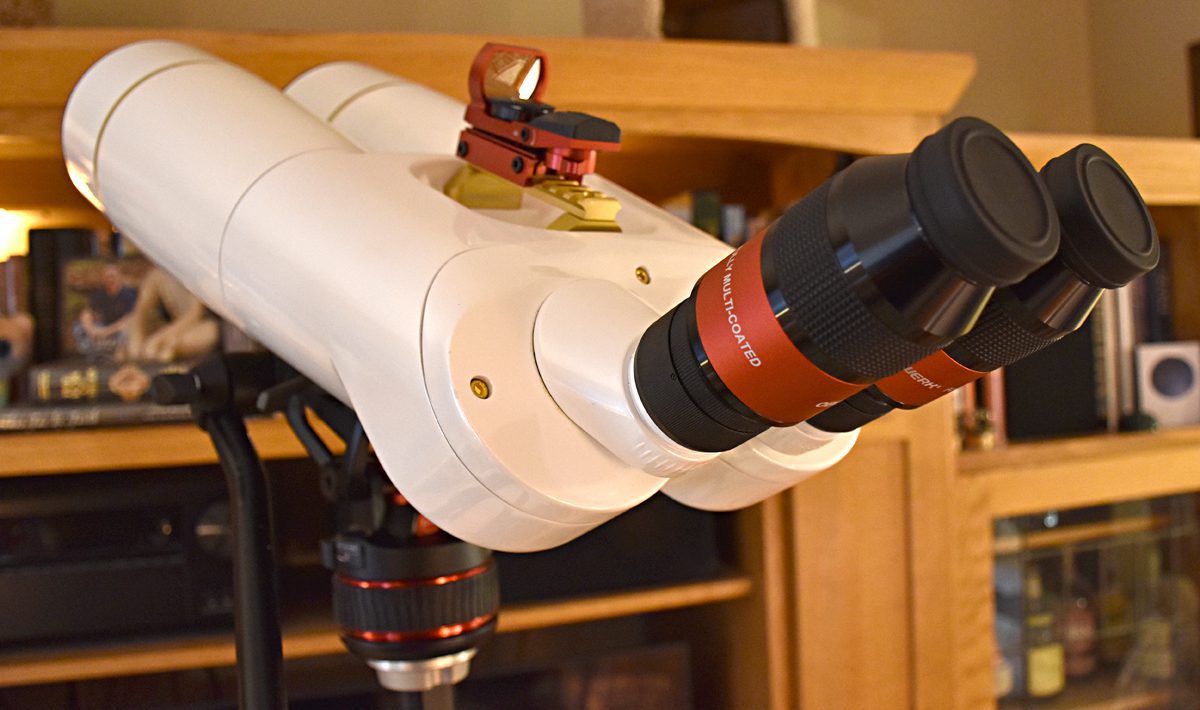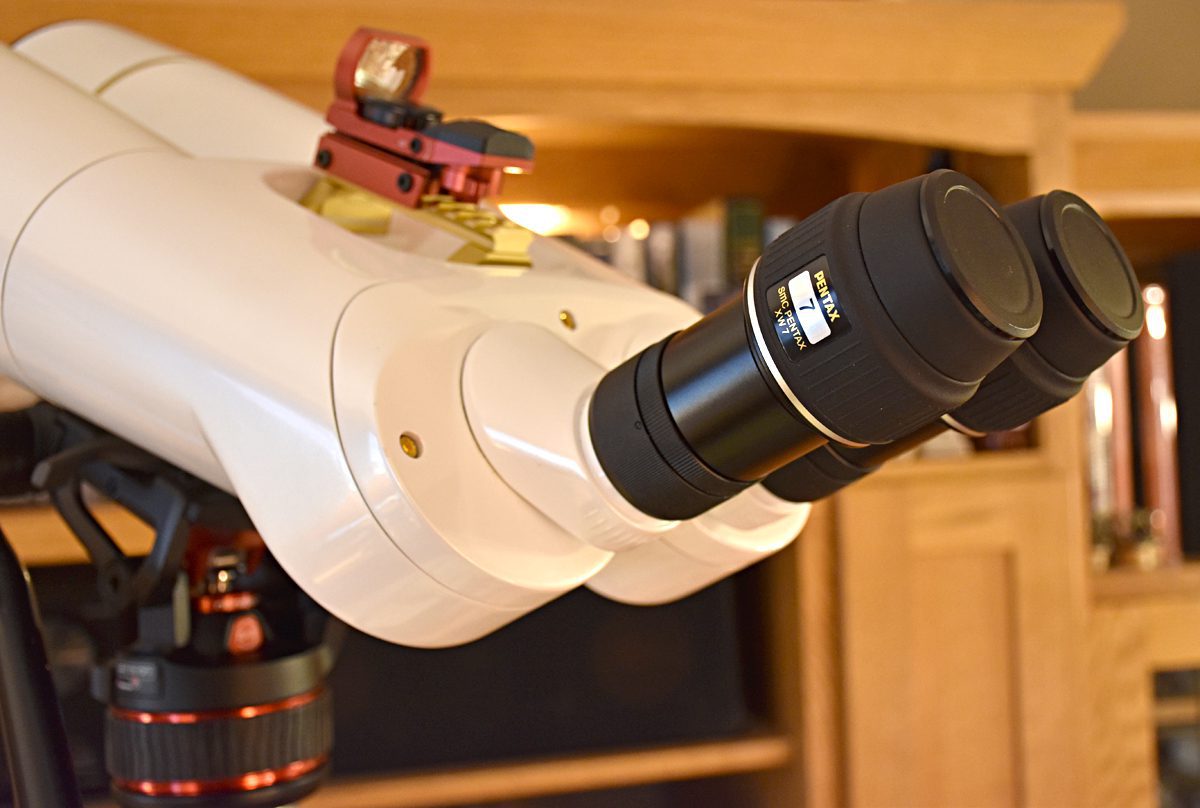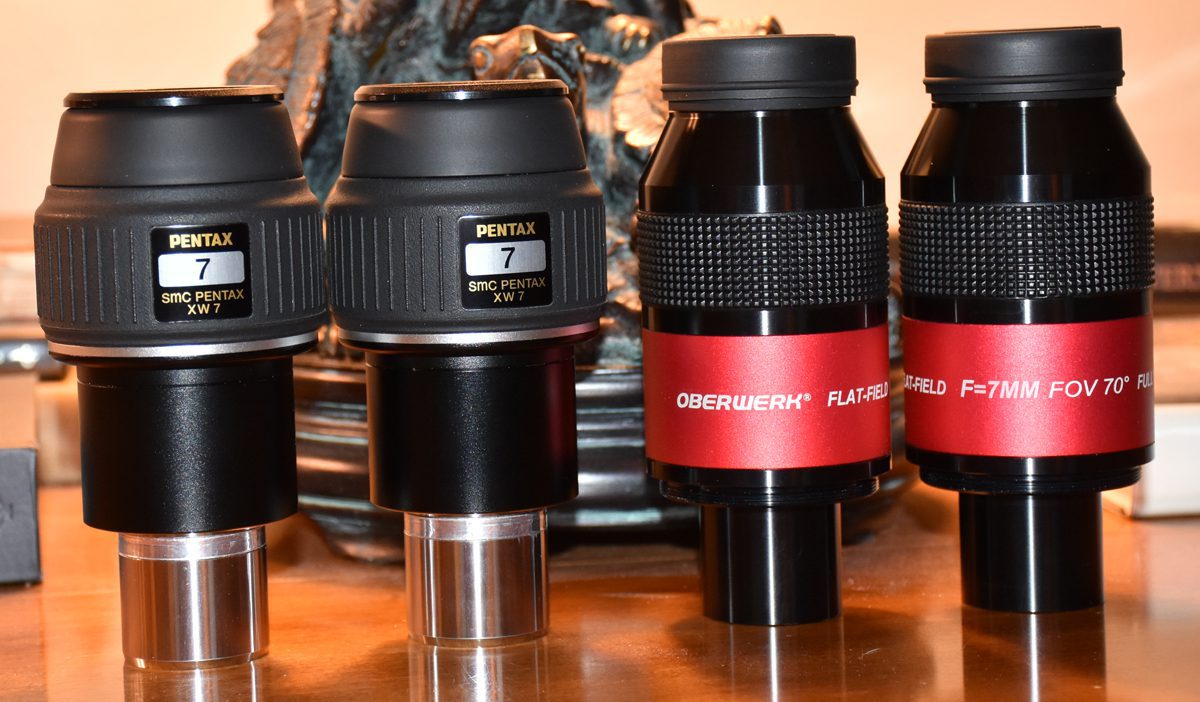
I recently added Oberwerk 7mm XL eyepieces to my equipment collection for the purpose of doing comparisons with the 7mm eyepieces I customarily use – Pentax 7mm XWs. A collimation issue has been reported concerning the XL 7mm eyepieces, such that the eyepieces have to be loosened in holders and rotated one or the other until the star images on both sides align, and then retightened without permitting the eyepieces to rotate in the tightening process). Laborious and frustrating.
I own half a dozen Oberwerk XL binocular telescopes (basically every size offered), even both -ED and SD versions in the 82XL. (Though they are too kind to say, my friends probably view this behavior as a bit on the OCD side. 😉 Maybe more than a bit. 😏) I mostly observe with Pentax XW eyepieces, including 20, 14, 10, 7, and 5mm sizes. My most used eyepieces are the 20s and 14s (about 85% of the time). The 10s are used about 10% of the time. The 7s about 3%. And the 5s about 2%. My observing is skewed strongly toward the lower magnification of the XL range, where to me binocular telescopes can be used to best advantage viewing wide starfields with the least mounting, focusing, and eye position headaches.
In keeping with my equipment review practices, my plan is to make a series of side by side observations using both the XL and Pentax 7mm eyepieces on different evenings, different objects, and from different locations to get a full picture of the relative strengths of each eyepiece design.

The Pentax XWs are one of the great contemporary eyepiece designs, and are priced accordingly. They are double the price of the Oberwerk XL eyepieces. The XLs deliver bang-for the buck performance, providing enjoyable wide apparent fields of view (AFOV), with strong on-axis performance, and edge performance that is good enough not to be distracting. Their optical performance is not on the level of the Pentax XWs, but for half the price they are an excellent value.
My first side by side comparisons were made Wednesday 29 March 2023 from my suburban yard (Bortle 7 skies), with a bright waxing gibbous moon. So not ideal for deep sky observation, but a surprising amount can still be seen, even under such conditions. Once I would not have bothered observing with such a bright moon in the sky (other than lunar or planet views), but I have found that the best objects for suburban observation – star clusters, double stars, carbon stars, asterisms, and bright deep sky objects – can still be enjoyed in bright moonlight. Okay, navigation is a little more challenging, but with practice that is managed easily enough.

NGC 2129
I chose this lesser known cluster in Gemini for comparison observations, really because it was high on my to observe list. It is near a conjunction of the Gemini border with both Taurus and Orion, just west of 1 Geminorum. Cluster members around the northern bright star (of the pair) were more apparent than those around the southern. Really just a sprinkling of stars with perhaps eight more hovering at the edge of averted vision. The XL7 performed credibly, given its modest price, compared with the Pentax. On axis it was reasonably sharp, though the Pentax was a touch brighter and showed a few more stars. The difference was noticeable but not dramatic. The Pentax edge sharpness is noticeably better, but the XL7 edge performance is still reasonably good and not distracting.
I did not have any trouble with “collimation,” and am not sure how to account for experiences some of my friends have had with these eyepieces. I am careful to seat the eyepieces firmly against the holder face, with the BT oriented so that the face of the holder is horizontal with the ground, not at an angle. Also, I tighten the lock rings firmly as well. The Oberwerk 7mm eyepieces have a wider base than the Pentax, which makes it more difficult to hold them firmly in place while tightening the lock ring, which might be part of the problem. The 7s I received have a threaded section just below the wide shoulder of the eyepiece, which is smaller in diameter than the holder face and helps to keep the eyepiece grounded. A good friend on Cloudy Nights, Rich V, suggested that nylon cable ties could be strapped to the lock rings, providing a finger tab for leverage when tightening – an inexpensive, reversible, highly effective enhancement.

Here are a few other things to note about the two designs. The Pentax XW eyepieces have recessed groves in the 1.25-inch inserts, which interfere with lock ring action and can be a nuisance. The XL inserts are smooth sided (an advantage). An effective work-around is to fill the Pentax groves with HVAC foil tape, being careful to ensure the level of the tape is below the surface of the insert. The clamps work fine with the filled in recess – overfilling it so that the tape projects above the surface of the insert exacerbates collimation problems for sure.
The XL eyepieces have fold down eyecups, enabling them to be quickly configured for eyeglass or non-eyeglass wearers. The Pentax XW “volcano tops” are adjustable, but have very fine threads to tune the eye relief position precisely. These are terrific for use by a single observer – the most adjustable and comfortable eyecups I have tried – but they are a nuisance to reconfigure for multiple observers.


Hi Fiske
After following you on cloudy nights I searched for Pentax 10mm xw, waiting for my second to arrive to use on my BT-82XL-ED. When you applied the HVAC tape, was it just a thin strip in the recessed grooves? Thanks so much and congratulations on your new site and Brand Ambassador for Oberwerk!
-if you come across a pearl white BT-100XL ED or SD, please drop me a note =)
Tammy
Hi, Tammy. Thanks for your comment. I used a paper cutter to make thin strips from a length of HVAC tape that was long enough to wrap around the diameter of the eyepiece tube with about 20% to spare. Then I wrapped several pieces to fill in the recess, offsetting the starting point of each piece to distribute the overlap and avoid creating a hump. It’s important that the filler not extend above the surface of the insert tube — it’s okay for the recess to be slightly underfilled. The lockrings will still work. If the tape extends above the surface of the insert tube, it will cause collimation problems because the eyepieces will cant slightly in the holders.